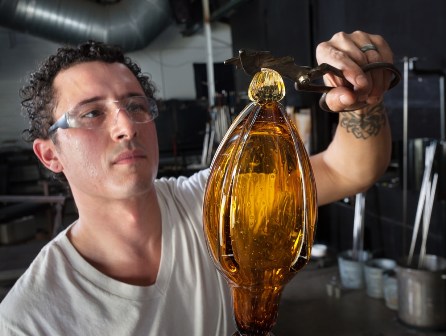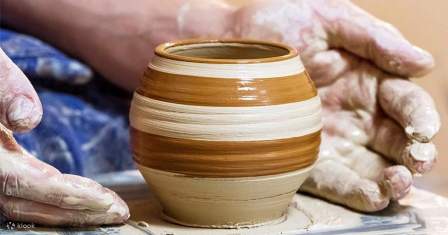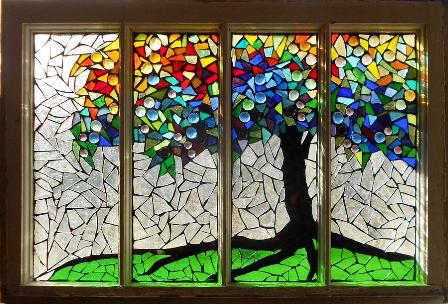
Ceramic and Glass Designing
A ceramic and glass designer is a professional who specializes in creating artistic and functional objects using ceramics and glass as their primary mediums. These designers combine their artistic creativity with technical skill to craft a wide range of items, from decorative pieces to functional objects. Their work often involves shaping, molding, firing, and manipulating ceramics and glass to achieve desired forms, textures, and visual effects. Ceramic and glass designers play a significant role in the world of art, design, and craftsmanship, contributing to both aesthetic beauty and practical utility.
Ceramic and glass designers possess a blend of artistic talents, technical proficiency, and a deep understanding of their chosen materials. They may work independently as artists, artisans, or craftspeople, selling their pieces through galleries, exhibitions, and online platforms. They can also collaborate with interior designers, architects, and other professionals to create unique pieces that complement various spaces.
In addition to creating functional items, ceramic and glass designers contribute to the world of fine art and craftsmanship, producing pieces that can be appreciated both for their aesthetic beauty and the skillful mastery of their chosen mediums.
Role Desciption
Roles and Responsibilities:
- Design Conceptualization: Ceramic and glass designers start by generating creative ideas for their projects, often drawing inspiration from nature, culture, art, and personal experiences.
- Material Selection: They choose appropriate types of ceramics or glass based on the intended purpose and design concept of their work.
- Design Development: After conceptualizing the design, they create detailed sketches, plans, or prototypes of their pieces to guide the crafting process.
- Crafting Techniques: Ceramic designers create pottery and sculptures using techniques like wheel throwing, handbuilding, molding, and glazing. Glass designers work with techniques such as blowing, fusing, slumping, and casting.
- Material Manipulation: They shape, mold, carve, and manipulate ceramics and glass during the crafting process to achieve the desired form, texture, and aesthetic.
- Color and Texture: Ceramic and glass designers experiment with colors, patterns, and textures to create unique visual effects in their pieces.
- Firing and Kiln Management: Ceramic designers fire their creations in kilns to achieve the desired hardness and appearance. They manage firing schedules and temperatures.
- Safety and Sustainability: They follow safety protocols when working with glass and ceramics, ensuring proper ventilation, handling, and disposal of materials.
- Quality Control: Designers inspect their finished pieces to ensure they meet quality standards and design specifications.
- Customization: They may work on commissioned projects, creating custom pieces according to clients' preferences and requirements.
- Portfolio Development: Building a portfolio of their work is essential for showcasing their skills and attracting clients or employers.
Eligibility
Route to become a Ceramic and glass designer
| Route 1 | 10+2 in any stream (Preferably Arts) |
| B.F.A.in Design (Ceramic & Glass)/ B.Des in Ceramic & Glass Design | |
| M.F.A.in Design (Ceramic & Glass)/ M.Des in Ceramic & Glass Design | |
| Route 2 | 10+2 in Science with PCM |
| B.Tech. in Ceramic Engineering / B. Tech in Ceramic Technology | |
| M.Tech. in Ceramic Engineering/ M. Tech in Ceramic Technology |
Significant Statistics
- You need to clear these entrance exams through which you can get admission to Ceramic and Glass Designing courses – NID Entrance Exam, Central Universities Common Entrance Test, JEE Main, JEE Advanced
- Some institutes in India offer specific programs in ceramics and glass designing. Look for postgraduate diploma or degree programs that provide comprehensive training in these areas.
- Develop a strong sense of aesthetics, creativity, and an eye for design.
- Learn various ceramics techniques such as hand-building, wheel throwing, glazing, and firing.
- Participate in workshops and internships with established ceramic and glass artists or studios. This hands-on experience will help you learn practical skills and gain exposure to the industry.
- Develop a portfolio showcasing your ceramic and glass works. Include a variety of projects that highlight your skills, creativity, and versatility.
Pros/Cons
Pros:
- Opportunities for artistic expression and innovation.
- Creating functional and decorative pieces that can last for generations.
- The satisfaction of seeing a project come to life through craftsmanship.
- Possibility to specialize in specific techniques or styles.
- Potential for collaborations with other artists and designers.
Cons:
- High level of technical skill required.
- Physical demands, such as working with heavy materials and exposure to heat (for ceramics) or potential risks (for glass blowing).
- Potential for materials to be fragile and break during production.
- Market competition in the field of handmade ceramics and glass art.
- Investment in equipment and materials.
Leading Professions
View All
Ceramic Studio Artist
Independent artists who ...
4.0LPA

Ceramic Sculptor
Specializing in creating...
4.0LPA

Glass Blower
Employing glass blowing ...
5.0LPA

Ceramic Potter
Creating functional and ...
3.0LPA

Glass Fuser
they use kiln-fired tech...
4.0LPA

Ceramic Tile Designer
They Design and create d...
4.0LPA

Glass Mosaic Artist
They Create intricate mo...
3.0LPA

Glass Engraver
They create intricate de...
3.0LPA
CAREER VIDEOS
Career Path
10+2 in any stream (Preferably Arts)
1 Steps
Skills
Recruitment Area
Art Studios and galleries ,
Workshops and Exhibitions ,
Craft Boutiques and Shops ,
Online Marketplaces ,
Craft Fairs and Art Markets ,
Interior Design Firms ,
Architectural Firms ,
Museums and Cultural Institutions ,
Ceramics and Glass Production Companies ,
Educational Institutions ,
Residential and Commercial Projects ,
Hot Glass Studios ,
Ceramic and Sculpture Studios ,
Hotel and Hospitality Industry ,
Sustainable and Eco-Friendly Initiatives .
Recruiters
Titan ,
Heath Ceramics ,
Wedgwood ,
Clayworks Studio ,
Tina Frey Designs ,
Dale Chihuly Studio ,
Orrefors ,
Murano Glass ,
Fused Glass Designs ,
Good Earth ,
Dovetail ,
AAVARAN ,
Tata ceramics ,
Ekmatra Fashion ,
Tripura Bamboo Mission Industries ,
Srijani .
Explore Colleges
Exams & Tests
Interested? Take the next step for this career
10+2 in any stream (Preferably Arts)
- 1 Steps
Skills Needed
Exams and Tests
Recruitment Area
Art Studios and galleries ,
Workshops and Exhibitions ,
Craft Boutiques and Shops ,
Online Marketplaces ,
Craft Fairs and Art Markets ,
Interior Design Firms ,
Architectural Firms ,
Museums and Cultural Institutions ,
Ceramics and Glass Production Companies ,
Educational Institutions ,
Residential and Commercial Projects ,
Hot Glass Studios ,
Ceramic and Sculpture Studios ,
Hotel and Hospitality Industry ,
Sustainable and Eco-Friendly Initiatives .
Recruiters
Titan ,
Heath Ceramics ,
Wedgwood ,
Clayworks Studio ,
Tina Frey Designs ,
Dale Chihuly Studio ,
Orrefors ,
Murano Glass ,
Fused Glass Designs ,
Good Earth ,
Dovetail ,
AAVARAN ,
Tata ceramics ,
Ekmatra Fashion ,
Tripura Bamboo Mission Industries ,
Srijani .



















